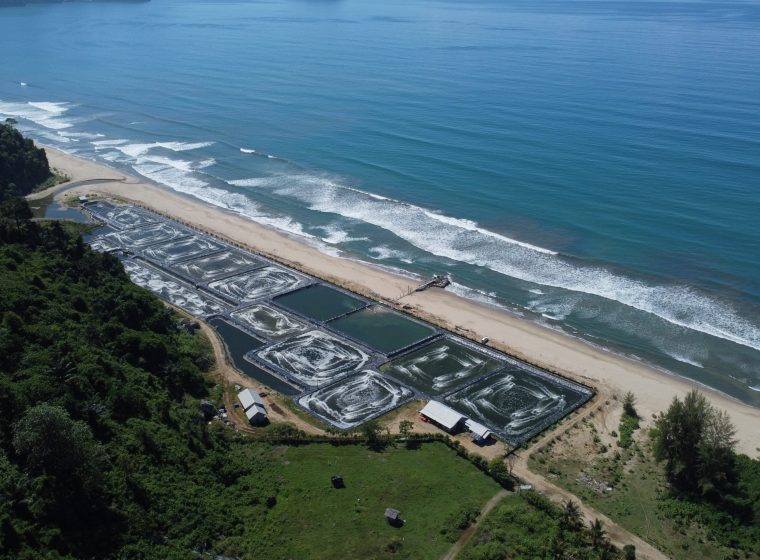Changing pond water is one solution to address water quality issues during cultivation. Pond water should be changed when its quality declines or certain conditions necessitate such action.
Fundamentally, water quality plays a crucial role in the success of aquaculture. Therefore, shrimp farmers must consistently monitor the conditions and quality of their pond water to ensure optimal shrimp growth.
When is the right time to change shrimp pond water? Find the answers in the following article!
Also Read: Water Quality Parameters in Shrimp Farms
Objectives of Changing Pond Water During Cultivation
1. Regulating Water Temperature
Water replacement helps regulate the pond water temperature, especially during extreme weather conditions. This is crucial to maintaining the water temperature within the optimal range for shrimp growth and health.
2. Preventing Salinity Increase During Dry Season
Water replacement becomes a vital strategy to prevent excessive salinity, especially during the dry season. High salinity can harm shrimp’s health and reduce pond productivity.
3. Increasing Dissolved Oxygen (DO) Concentration
The water-changing process helps increase the concentration of dissolved oxygen in the pond. Adequate oxygen availability is crucial for shrimp metabolism and preventing hypoxic conditions.
4. Removing Excess Phytoplankton
Changing water helps control the phytoplankton population in the pond. Excessive phytoplankton can cause unstable water conditions and negatively impact shrimp health.
5. Reducing Nutrient Concentrations
The water-changing process helps reduce nutrient concentrations in the pond. Excessive nutrients can lead to algal growth and pose ecological issues in the pond.
6. Lowering Concentrations of Ammonia, Nitrate, or Nitrite
Water replacement plays a role in reducing concentrations of harmful substances such as ammonia, nitrate, or nitrite. High concentrations can adversely affect shrimp’s health and lead to various health problems.
7. Eliminating Metabolism By-Products
Water replacement assists in removing accumulated metabolic by-products of shrimp in the pond. This prevents the buildup of substances that can be harmful.
8. Replacing Lost Water due to Evaporation or Leaks
In addition to maintaining water quality, water replacement also serves to replace lost water due to natural evaporation or leaks. This helps maintain the stability of the pond water volume.
Also Read: Application of Proper Biosecurity for Shrimp Ponds
Indicators for the Right Time to Change Shrimp Pond Water
Before changing pond water, it is essential to recognize the signs indicating the right time for this action, including:
1. Significant Increase in pH > 0.5 or Above the Specified Limit
A significant change in pH levels suggests the need for water replacement. An increase of more than 0.5 from the normal limit indicates instability that can harm shrimp.
2. Change in Water Color
Changes in water color, whether becoming clear with clarity exceeding 80 cm or becoming turbid with clarity less than 30 cm, are indicators that pond water quality needs improvement through water replacement.
3. High Organic Matter in Pond Water
Accumulation of organic matter in pond water can affect water quality. If there is a significant increase, changing pond water can help reduce the burden of organic matter in the pond.
4. Decrease in Shrimp Feeding Appetite
A decrease in shrimp feeding appetite may indicate stress or health issues. Changing pond water can create a better environment for shrimp, enhancing their feeding appetite.
5. Occurrence of Plankton Blooms
Excessive plankton blooms can cause significant changes in water quality. Water replacement helps control plankton populations and prevents potential issues.
6. Increased Shrimp Mortality
If there is an unexplained increase in shrimp mortality, it may be a sign that pond water conditions need evaluation and potential water replacement.
7. Abundant Sediment at the Pond Bottom
Excessive sediment at the pond bottom can indicate that pond water needs replacement. Changing pond water helps reduce sediment levels and maintains pond bottom cleanliness.
8. High Vibrio Content in the Pond
Elevated levels of Vibrio bacteria in pond water may indicate potential shrimp health problems. Water replacement can help reduce the number of pathogenic bacteria in the pond.
Also Read: How to Properly and Completely Distribute Vannamei Shrimp Fry!
Record and Monitor Your Pond Water Quality with AquaHero!
Changing shrimp pond water should not be done arbitrarily. Therefore, shrimp farmers must pay attention to the timing and procedures for changing shrimp pond water to ensure the quality of their shrimp’s lives is not disrupted.
To determine when your pond water should be replaced, you can monitor your pond water quality using AquaHero!
AquaHero is an application developed by DELOS to make it easy for you to monitor your pond conditions daily. From water quality to shrimp growth, action recommendations, and even the break-even point estimation during cultivation.
Contact the DELOS Team at contact@delosaqua.com or submit through the contact form on our website at www.delosaqua.com to try out AquaHero’s features and make shrimp cultivation easier and traceable. Choose AquaHero to record and monitor your pond water quality!




